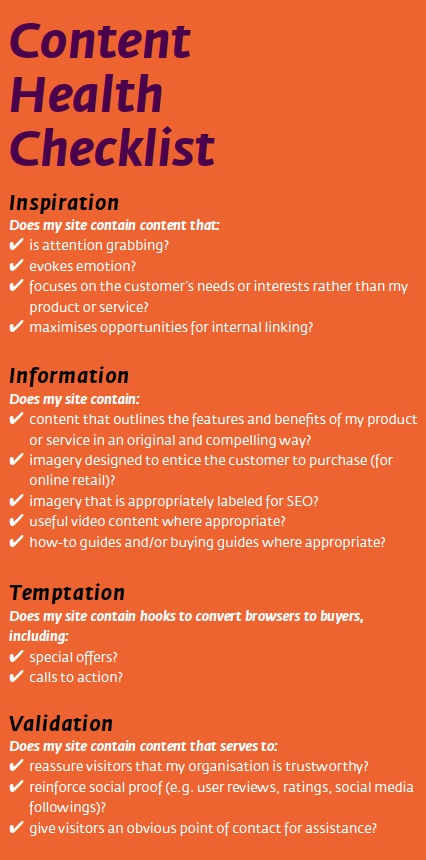How To Audit Content
- Home
- Service

Content Audit
How To Audit Content?
What Is Content Audit?
Your website is the heartbeat of your brand. It’s the piece that connects traffic with conversions. So the first step when embarking on a content marketing strategy should be a frank and thorough content audit or ‘health check’ of your site’s content.
A useful framework for this exercise is The Four Pillars: Inspiration, Information, Temptation and Validation. These are the motivations that drive your consumer through their purchasing journey, so it makes sense that they form the basis for your site appraisal.

What exactly is a content audit?
It’s the process of tracking down and organizing all content that you have in your website.
What Are The Process Of Content Audit Useful?
1. Inspiration
Inspiration can come into play before your site visitor has even considered purchasing from you or using your services. This content is non-product specific and should serve as a hook to grab attention and/or evoke emotion.
Inspiration can take the form of blogs, infographics, whitepapers, imagery, or other content that draws the visitor in and unearths an idea or a need that your brand could potentially address.
Blogs
Recent research by marketing tech firm Hubspot found that blogging produced a new customer for 43 percent of marketers, and that 79 percent of companies who blogged reported positive ROI from their approach. A regularly updated blog is now standard fare in online retail, providing your target audience with inside information, helpful hints and shopping ideas. Every e-commerce site should have a blog feed delivering relevant posts on topics of interest.
More and more e-commerce retailers are ramping up their blogs as a rich source of informative, interesting and engaging content for their target audience. Blogs are being integrated into the e-commerce user experience, adding a publishing component to establish authority.
Highly successful online-only retailers like ASOS, Gilt, Mr Porter and One Kings Lane have invested heavily in blogging for great reward. Their customers are seeing them as valuable sources of information and advice on fashion and home décor.
To create a successful blog, you need to think about your audience rather than your product. “Too many companies start with thinking about their products instead of the buyer,” says Hubspot CMO Mike Volpe. “The idea is to compete for the buyer’s attention, not against other brands’ products.”
In order to maximise the search engine discoverability of your blog, use plenty of internal links. You can link to product pages, category pages, videos, buying guides etc. This provides search engine crawlers with a clear guide that there is plenty of relevant and interconnected content on your site. According to social media guru Jeff Bullas, articles with images receive 94 percent more views, so be sure to use imagery wherever you can. To maximise traffic to your blog, you should also share content via social media.
Inforgraphics
Infographics have become an extremely popular way to provide a snapshot of information. Infographics can be generated from scratch or they can be a way to repurpose existing written content or research findings. As with blogs, infographics should be driven by your audience’s needs or wants, rather than focusing too heavily on your products or services.
A good example of this is an infographic produced by Cheapflights.co.uk that takes a tongue-in-cheek look at how to order coffee around the world, along with some interesting global coffee trivia.
Whitepapers and E-books
Whitepapers and e-books are an excellent way for B2B brands to establish themselves as thought leaders in their field. They are also a great way to gather leads as visitors generally expect that they will have to surrender some contact information in exchange for a brand’s content. If you are using whitepapers for lead generation purposes, it’s best to only ask for a bare minimum of information (name, email address) to minimise the risk of deterring people from downloading.
Pod Legal is a boutique law firm that makes very good use of e-books (and podcasts) with topics such as ‘Your website: Is It Exposing You To Legal Risk?’ Unlike most e-books, however, there is no requirement to register to download the material. This can actually be a good way to build trust before you request any personal details of your prospective customers.
2. Information
Product Description
An alarming number of e-commerce businesses neglect their product pages, defaulting to the most basic set-ups and often committing the most outrageous sin in modern retail – no product descriptions! Using product descriptions that outline the features and benefits in a compelling way will boost sales, and is more than worth the effort. Original product descriptions will also do great things for your search traffic. Using the manufacturer’s description that appears on other sites will cost you valuable ranking points with Google, so it pays to rewrite them yourself.
For companies with a high SKU count, writing thousands of product descriptions can be a daunting and costly task. However, it’s a tried and tested driver of return on investment, and essential for being competitive. Prove the concept by focusing on a sample of the range, and once you start to see the results, roll out across the entire range.
For online retailers looking to build a brand and engagement, cleverly written product descriptions can be a great differentiator. Look at Sneaking Duck (a site selling designer eyewear) and Vinomofo (a flash sales wine site) for examples of compelling, original product descriptions.


Product Imagery
Product imagery is arguably more important than the words, depending on the category. Certainly that would be the case for fashion, though the product description becomes an essential accoutrement to the imagery to help entice the customer to purchase.
Product imagery should be consistent, and product pages should include multiple shots, with a zoom function. Art directed, quality imagery coupled with well-written product descriptions is absolutely going to set your site apart and drive higher conversions. Again, test this on a small sample-size, and if the conversion rates rise and you see ROI, roll it out full scale.
Make sure you rename the image to something descriptive to aid SEO (eg. HHMT123475.jpg becomes Quiksilver_T-shirt771.jpg). Add the Alt tag so search engines crawling your site know what the content of the image is and can index it appropriately.
Video
Helpful short videos are becoming de rigeur in online retail as a further means of closing the sale. Online fashion retailer ASOS features models hitting the catwalk in every piece right alongside the still shots. Both stills and video are shot at the same time, and ASOS says the videos are even faster to produce than the stills. Plus, ASOS saw an immediate uplift in conversions when these videos were added, and video is now core to its strategy. Pureplay jewellery retailer Ice.com deployed product videos and immediately saw a 22 percent reduction in returns.
Instructional videos are also integral to e-commerce success – short, helpful videos describing how a product works or showing it in action. You don’t need high production values to succeed – eBags.com uses videos of in-house experts showing all of a bag’s features to great effect, and credit video as playing a significant part in increasing conversions.
Place your video intelligently to give yourself the best chance of converting the browser to a buyer – ideally on the product page. You don’t want to be sending customers away from the products to a whole new video area, where they may not be inclined to navigate back.


How-tos and Buying Guides
3. Temptation
Temptation covers the tools that spell out promotions and features and entice your browsers over the line to become buyers. This is where you feature special offers or calls to action. Examples of Temptation content include anything that might encourage your site visitors to spend more, sign up or join a club. This could be general content aimed at all site visitors or it could be tailored, based on past purchasing behaviour or items currently in the shopping cart.
Online makeup retailer Sephora.com does a great job of Temptation with features such as ‘Complete your skincare routine’ which suggests additional products related to what’s in your basket, as well as a reminder that ‘You’re only $X away from free shipping’ to entice you to buy more.
Australian online hardware retailer Masters.com.au is also doing a good job of Temptation content, with a homepage that features a rotating carousel of promotional offers, as well as a prominently featured ‘Best Price Guarantee’ and promise of ‘24 Months Interest Free’. In a similar vein to Sephora, Masters also features related products with a ‘Customers also viewed’ function on product pages.
4. Validation
Validation is a critical component of your site’s content from the beginning to the end of your customer’s time on-site. This is the content that reassures visitors that you are a legitimate organisation and that you are trustworthy and customer-focused. Shopping carts and checkouts are crucial dropout points – the vast majority of purchase abandonment occurs here, yet these are the areas most overlooked for Validation content.
Half the job of an online retailer is not only to get people to buy from you, but to buy online, period. The depth of helpful, friendly information you feature on your site goes a long way to reassuring potential customers you can be trusted.

Examples of Validation content include: user-generated ratings and reviews, trust markers (such as tallies of social media followings, respected transaction security symbols, relevant accreditations) and comfort content (including contact information, and returns and exchange policies). Remind users at every opportunity that your site is safe, secure and trustworthy – and make it clear there are help options should they feel uncomfortable at any point in the purchase journey.
Australia’s largest online department store, DealsDirect, does an excellent job of providing reassurance to customers throughout the entire process.
DealsDirect includes helpful information about returns and exchange policies and
provides five fundamental reasons why customers should shop with the retailer, as well as easy-to-use customer service options that are displayed prominently on the site.
Online clothing retailer Zappos.com also does a good job of providing Validation content, including a prominently featured 24/7 customer helpline, live chat option, clearly displayed free shipping and returns policy and a section below the fold dedicated to customer service – including FAQs, contact info, shipping and returns policy and a safe shopping guarantee.
With search engine traffic now holding the key to the fortunes of so many businesses, it’s important to get your content writing right – starting with your website. Once you have these Four Pillars in order, you are well on your way to stimulating thought and inspiring the action you want your consumers to take.
We Best SEO Company Australia have help many business with content marketing, you can contact us if you required content writing services.


